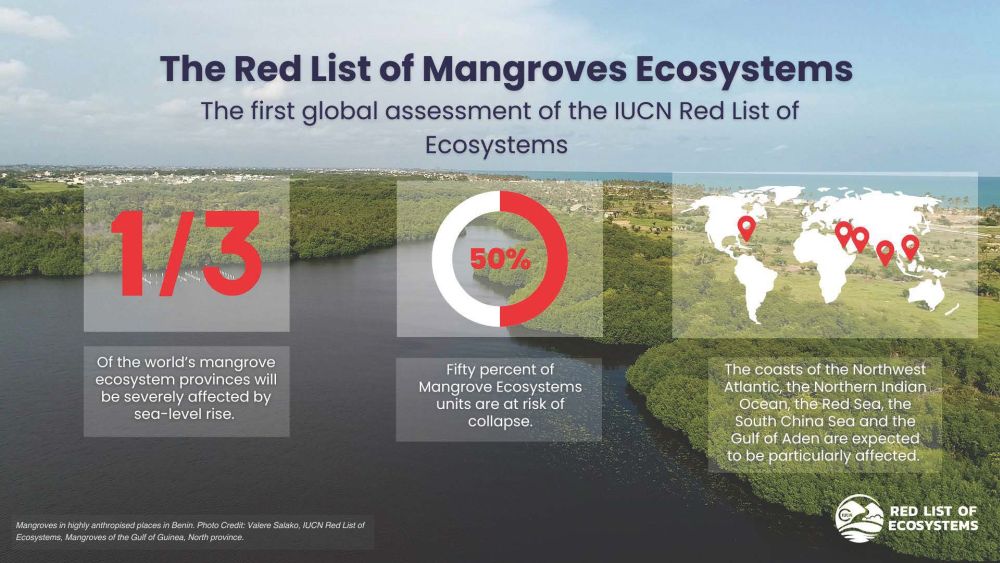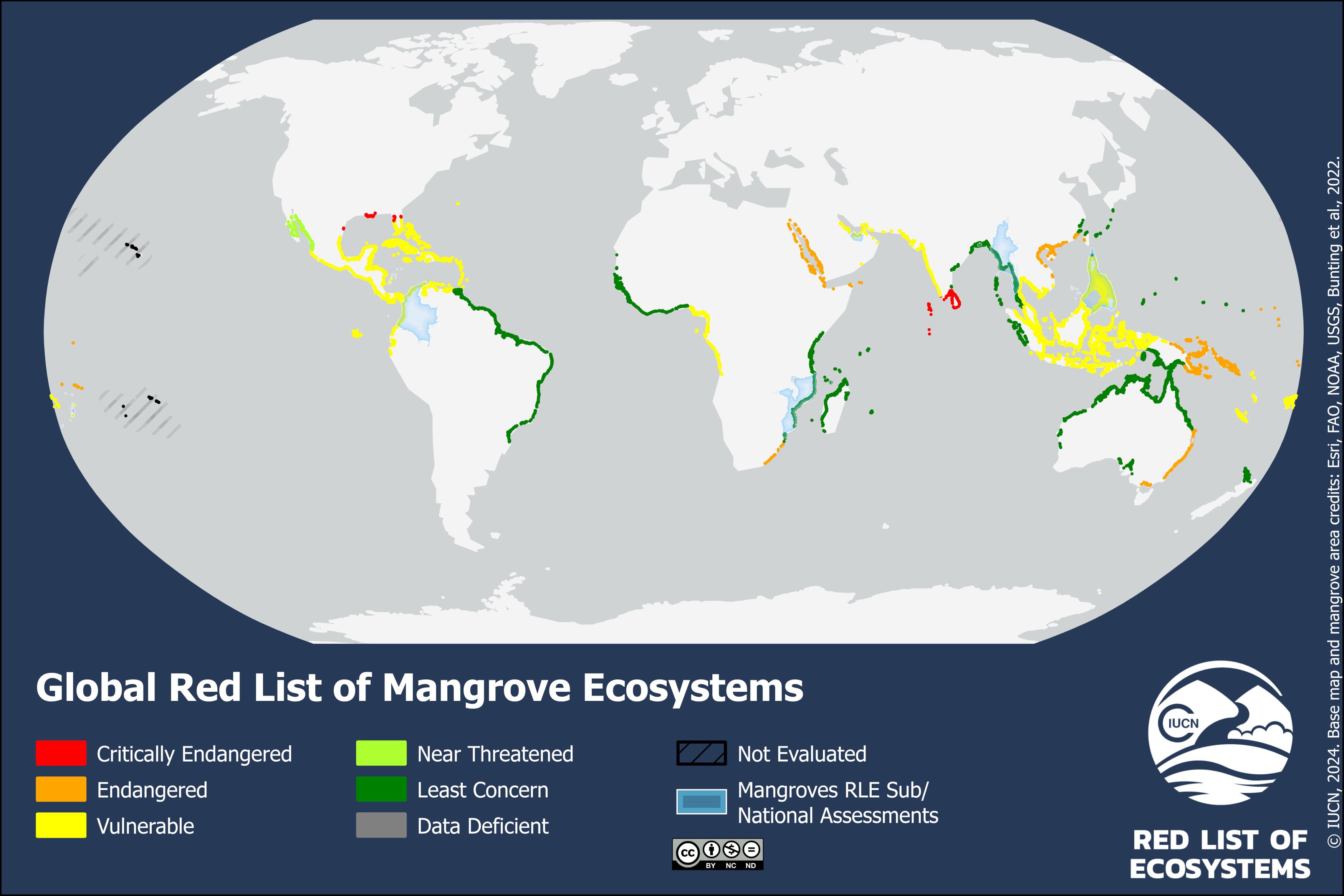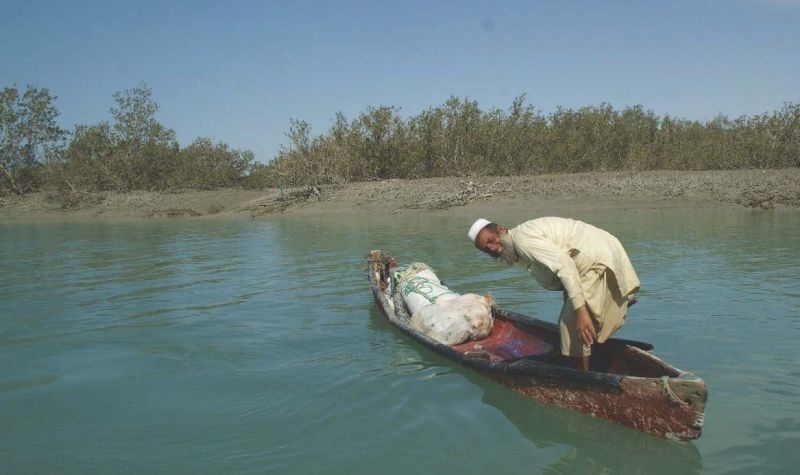The first-ever global assessment for the IUCN Red List of Ecosystems reveals that more than half of the world's mangroves are at risk of collapse by 2050
The new publication of the Red List of Mangrove Ecosystems on May 22, 2024, marks a significant milestone. As the first-ever global assessment of an entire ecosystem functional group, this report employs The Red List of Ecosystems framework to highlight alarming concerns about the potential collapse of mangrove ecosystems worldwide.

Key findings
This global assessment shows that 50% of mangrove ecosystems are at risk of collapse. In the absence of additional conservation efforts, by 2050, about 7,065 km2(- 5%) more mangroves will be lost and 23,672 km2 (-16%) will be submerged due to sea level rise.

This work has been led by IUCN, but the results possible thanks to collaboration and reviewed by more than 250 experts worldwide from 44 countries where mangroves occur.
If we let this happen, the world is at risk of losing:
-
1.8 billion tonnes of carbon stored, representing a cost to society equal to $336 billion based on the social cost of carbon.
-
Protection for 2.1 million lives exposed to coastal flooding (14.5% of current lives exposed) and $36 billion worth in protection value to properties (35.7% of current property values protected).
-
17 million days of fishing effort per year (14% of current fishing effort supported by mangroves).
Sea-level rise is the main threat affecting mangrove ecosystems.
According to the methodology used- if we continue at the current rate:
-
25% of the global mangrove area is predicted to be submerged in the next 50 Years.
-
1/3 of the world’s mangrove ecosystem provinces will be severely affected by sea-level rise.
-
The impact of sea-level rise on mangrove ecosystems will differ regionally: the Northwest Atlantic, North Indian Ocean, Red Sea, South China Sea, and Gulf of Aden coasts are expected to be particularly severely affected.
Additionally, while the rate of loss of mangrove area caused by direct human activities has slowed in many ecoregions e.g. Sunda Shelf, the rate of loss remains alarming for mangroves in other ecoregions, e.g. Gulf of Guinea South. About 19% of the mangrove ecosystems are affected by this past decline in mangrove surface.
Conclusions and next steps:
Mangrove ecosystems flourish in tropical, humid regions, yet they face an escalating threat from climate change. The increased frequency and intensity of cyclones, typhoons, hurricanes, and tropical storms are already impacting mangroves along many coastlines. Sea-level rise, although a global process, will affect regions differently—some mangroves will only be mildly impacted, especially those on elevated shores or receiving sufficient sediment flows to keep pace with rising waters.
Climate change is altering the distribution of mangroves, leading to observable changes such as their expansion into temperate areas, like parts of the Pacific, where they were previously absent.

Small scale fishing in a mangrove-fringed lagoon in Balochistan Province, Pakistan. Photo Credit: Don Macintosh, IUCN Red List of Ecosystems, Mangroves of the Arabian (Persian) Gulf.
Conversely, in arid regions, the combination of climate change and freshwater diversion for agricultural irrigation has led to insufficient freshwater and sediment supplies, jeopardizing mangrove survival and growth.
The publication of the Red List of Mangrove Ecosystems on May 22, 2024, represents a significant milestone. As a headline indicator for the Kunming-Montreal Global Biodiversity Framework, this assessment has identified the primary threats to mangrove degradation and loss worldwide. This global perspective is valuable because many key ecological functions of mangroves, as well as their goods and services, are transboundary and regional in nature.
Historically, threats to mangroves included wood exploitation, deforestation for agriculture, and shrimp farming, as well as indirect impacts from dam construction that altered freshwater and sediment fluxes. Today, these ecosystems face additional challenges from climate change, including sea-level rise and more frequent and severe cyclonic storms. The assessment has pinpointed both widespread and site-specific threats, along with their underlying drivers.
Maintaining the integrity of these ecosystems is crucial for coping with climate change impacts. Preserving old-growth mangrove forests, for example, will enhance the resilience of the system and the capacity of other mangrove areas to recover and adapt. The Red List of Mangrove Ecosystems study contributes towards achieving global goals for mangroves. Initiatives like the Mangrove Breakthrough, which aims to secure the future of 150,000 km² of mangroves, should incorporate these identified risks into their conservation management strategies.
This global study is hoped to guide future national assessments and actions to mitigate further mangrove loss through informed decision-making. However, countries are encouraged to use national, sub-national, or other lower-scale assessment results whenever available to ensure the most effective conservation efforts.
Read more about the methodology framework here.
